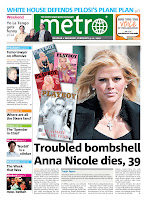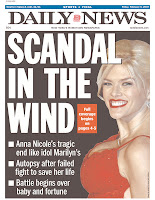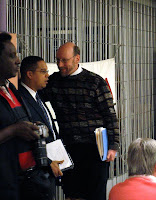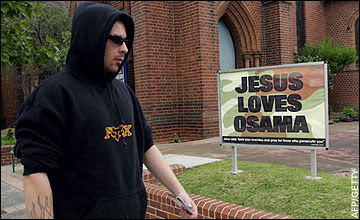
Where were you when you heard about Anna Nicole Smith's death?
An odd question, for sure, since it seems to put the tragic end of a Playboy/Guess model's life last Thursday in the same category as, say, John F. Kennedy's assassination or the Sept. 11 terrorist attacks.
But seriously, where were you? I was at work, and a friend who gets CNN's breaking headlines via email told me about it. I definitely didn't learn about it by cracking open a newspaper. Yet, 12 or so hours later, when the morning edition of the Star Tribune came out, there was the news I—and the majority of the Web-connected, cable-news-watching, SMS-enabled, or e-mail-alerted world—already knew, right on the front cover.
But on Feb. 9, my morning paper wasn't alone.
Of the 300 U.S. papers whose covers are recorded at the site Newseum each day, all but two dozen—not even 10 percent of the papers—deemed it big enough news to merit front-page coverage. Some used the photo to tease readers inside to learn more on Smith's demise, while many began telling of her collapse and death right there, along with the killing of American GIs in Iraq and whatever local happenings were deemed cover-worthy.
Why did the majority of these papers deem Anna Nicole Smith among the most important news of the day? Is a celebrity's death more "newsy" than, say, the power-sharing deal brokered by Fatah and Hamas in Palestine (which appeared on A3 of the Star Tribune that day), or developments in the case of the cab driver who was brutally gunned down in Brooklyn Center (reported on B4)? How come Smith, whose intellectual contributions to culture paled in comparison of those of writer Molly Ivins (who died Jan. 30), got front page placement when Ivins, who began her career as an employee of the Minneapolis paper, didn't?

Before the whys, here's the how-much: On a day that
four Marines were killed and
the sixth U.S. helicopter in three weeks was shot down in Iraq, Smith gobbled up the majority of cable's news programs. She was mentioned on CNN 522 percent more frequently than Iraq and 708 percent more often on MSNBC, according to ThinkProgress. And both the Los Angeles Times and Washington Post gave cover prominence to the story. The New York Times didn't—but it did
purchase a "sponsored link" to "Anna Nicole Smith" on Google.
To state the obvious, America tunes in to lurid tales of rises and falls, rags and riches, T and A—a fact not lost on those who work in media. They just couch it in different terms.
Star Tribune managing editor Scott Gillespie acknowledged that Smith's death was a "talker," the stuff of proverbial water-cooler chat the next day. That talk factor "was helped—helped in a horrible way—by the recent death of her son, which is still mysterious," he said. Kate Parry, the paper's readers' representative, blogged on Thursday afternoon that "
it was instantly the top-read story on startribune.com," echoing CNN's Larry King who, en route to capturing the
coveted 25- to 54-year-old demographic that night, reported (or prophesied?), "The death of Anna Nicole Smith—it’s the number one story around the world tonight."
But what makes it news? A journalistic judgment on the part of editors or the public's insatiable demand for voyeuristic details? At the Los Angeles Times, Tim Rutten offers an answer: "[M]ainstream journalistic coverage of Smith's death is among the first such stories driven, in large part, by an editorial perception of public interest derived mainly from Internet traffic."
I'd argue with Rutten that this is the first such story: the Star Tribune's focus-group-tested redesign of October 2005 seems to be based in large part on "editorial perception of public interest." The paper partnered with Northwestern University's Readership Institute to reshape its content to better appeal to under-30 readers. Key to its success, they learned, was "intensifying" three experiences of readers: "Gives me something to talk about," "Looks out for my interests," or "Turned [me] on by surprise or humor." Outgoing editor Anders Gyllenhaal explained this so-called "experience newspaper" this way:
"Experiences are a way of converting traditional news judgment from editors’ definitions (what’s most interesting, what’s most important, what you just can’t believe happened) to readers’ definitions of how they react (what makes readers feel informed, what gives them something to talk about, what tells them the paper is looking out for their interests.)”
This trend toward consumer-driven news is what former Pioneer Press writer Jim Walsh seemed to reference in his final column for City Pages, his most recent gig, which ended abruptly when corporate bosses at New Times/Village Voice Media fired him two weeks ago. The piece, which never ran, chronicles the meeting of old-guard Pioneer Press writers at a St. Paul bar, where they lamented the death of journalism as they knew it:
The optimists talked about how there will always be a need for storytellers and good writing, no matter what the format or who/what owns/runs it. The pessimists talked about newspaper management’s desperation to woo younger readers with intelligence-insulting writing, blurbs and big graphics, and corporate ownership that values byline counts over originality, creativity, and flesh-and-blood connection with readers.
The rubbing elbows of it all, in other words, was an honest-to-God example of the human element – which, post-Enron, is the sort of grasp for grassroots credibility that corporations of all stripes are suddenly trying to replicate and fabricate (see: "Our Katie Couric" "My Star Tribune"; "My Starbucks"). And currently lost in the discussion about the corporate takeover of newspapers is how the process is slowly severing the intimate connection between readers and writers. Not to put too fine a point on it, but Annie in Andover doesn’t give a shit about who owns her paper; she cares about reading about what’s happening to her neighbors, including people who write for her newspaper.
While the Star Tribune's choice to give Anna Nicole A1 placement had little to do with what's happening in the neighborhoods of Minneapolis and St. Paul, reader's rep Kate Parry said there was fierce debate about how (and if) to include news about "the death of someone whose only claim to fame is a kind of notorious celebrity." She wrote of their conclusion:
Putting that person on page one as a straight obit could look sort of like gossip sheet fascination. But trying to find a story that explains why this unlikely person became the fascination of much of the country becomes an interesting sort of sociological approach.
Hence, the paper found an AP story that asked, "What so fascinates people about Anna Nicole Smith?" Written by Jocelyn Noveck, the story — which included three photos and almost 30 column inches of text — covered familiar terrain: Smith portrayed as the "perfect pop culture icon," "another sexy, tragic blonde" like Marilyn Monroe, and a "perverse Hollywood Horatio Alger story," while sprinkling in biographical tidbits about her days of topless dancing, teen pregnancy, the unexplained death of her son, and her famous marriage to an "89-year-old oil tycoon" (Tycoon? Is this a newspaper or "The Great Gatsby"?).

That have-your-cake-and-eat-it-too strategy seems a not-so-distant cousin to what the Los Angeles Times' Rutten calls "one of the cheapest journalistic tricks going" (and one this writer just might be engaging in): "[T]o get a piece of a mindless, tawdry media frenzy by denouncing it.
The writer gets to wallow profitably in whatever gutter has everybody's attention while still being wry and high-minded. The readers get to join the fun without losing their self-respect. It's a win-win sort of arrangement for a certain knowing-wink-and-sly-nod wing of the media culture."
The Strib's coverage, while lengthy, was downright honorable in comparison to New York Spanish language daily Hoy, which devoted nearly its entire cover Friday to an image that featured an unobstructed view of the underside of Smith's breast; the New York Daily News, which included a screaming headline, "Scandal in the Wind"; or Philadelphia's Metro, which showed four Playboy covers and a fifth photo of Smith. (Ever restrained, the Wall Street Journal didn't put Smith on their cover; for contrast, it would've been nice to see Smith rendered in WSJ's trademark pointillist pen-and-ink.)
But compared to others, like West Hawaii Today, the coverage seemed excessive. WHT's editor Reed Flickinger didn't see the story as front-page news at all. "Had she burst into flame, spontaneously, perhaps, but that would be because of the cause of death, not the nature of the deceased," he wrote in an email. "Putting Anna Nicole Smith on the cover is exactly what is wrong with journalism, and to a larger degree, this country, today."
The Strib's managing editor, Scott Gillespie, says this kind of gauging and fulfilling of reader desires isn't new at all. He said, "I think it's wrong to say we at the Star Tribune have just decided in the past couple of years to put 'talker' stories on the cover. We've been doing it for years. In all 15 of the years I've worked here, there's been an effort to find the story people will be talking about."
Call it what you will — Gillespie's "talker," Gyllenhaal's "experience," Larry King's "number one story" — this belief that local audiences are served by papers piling on popular celebrity stories seems to ignore journalism's role to not just provide what readers want, but what they need to know to be active citizens. Editors argue that if diverse content draws readers who, after getting their Smith fix, keep reading about the new ballot initiative or funding for a stadium, the public interest is served. My guess is that while daily papers are enhancing the reading experience with celebrity news, lifestyle tips, and feel-good front-cover fluff, magazines like People and U.S. Weekly won't be reciprocating by upping their local news coverage.
Said Kevin Kaufman, editor of the Boulder, Colo., Daily Camera, where a photo of Smith on the cover ran with a teaser for readers to look inside for more:
I put stories out front that I think are important, newsy, interesting, odd, unusual, etc., and that will attract readers, regardless of whether they involve a U.S. Senate vote on the Bush Iraq plan, the local government moving from parking meters to parking kiosks, recruiting of players for the local college football team, the entertainment industry or an astronaut driving 900 miles in a diaper.
 In her already-infamous podcast interview with St. Cloud Times reporter Larry Schumacher, U.S. Rep. Michelle Bachmann, R-Minn., sounded pretty certain Iran had "already decided" to partition Iraq. "There's already an agreement made," she said, to "create a terrorist safe haven zone" in the northwest part of Iraq. While iffy on the details, she even offered a name for the state that Iran would create: "The United... um, I'm sorry. I can't remember the name of it now, but it's going to be called the Iraq State of Islam, something like that."
In her already-infamous podcast interview with St. Cloud Times reporter Larry Schumacher, U.S. Rep. Michelle Bachmann, R-Minn., sounded pretty certain Iran had "already decided" to partition Iraq. "There's already an agreement made," she said, to "create a terrorist safe haven zone" in the northwest part of Iraq. While iffy on the details, she even offered a name for the state that Iran would create: "The United... um, I'm sorry. I can't remember the name of it now, but it's going to be called the Iraq State of Islam, something like that."





























